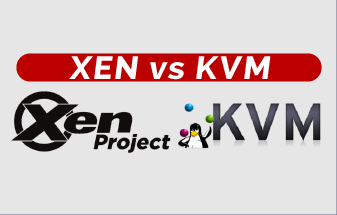
KVM and Xen are two of the most popular hypervisors for server virtualization. Both hypervisors have their unique features and characteristics which make them suitable for specific workloads and use cases. However, when it comes to choosing the right virtualization platform, there are a few differences to be considered between KVM Vs Xen performance.
The difference between KVM and Xen!

KVM, an acronym for Kernel-based Virtual Machine, is a hypervisor that is built into the Linux kernel. KVM uses hardware virtualization to achieve near-native performance, which means that the virtual machines running on KVM are almost as fast and efficient as the host operating system.
On the other hand, Xen is an open-source hypervisor that uses paravirtualization to achieve performance enhancements. Para-virtualization is a technique that enables guest operating systems to communicate directly with the hypervisor, bypassing the host operating system. This enables para-virtualized guests to be more efficient and have better performance compared to fully virtualized guests. However, para-virtualization can be more complex to implement, and not all operating systems are supported by Xen.
KVM Vs Xen Performance
One of the key differences affecting performance between KVM and Xen is their architecture. KVM is a full virtualization hypervisor while Xen is a paravirtualization hypervisor. This means that KVM runs unmodified guest operating systems and emulates hardware for the virtualized guests while Xen requires the guest operating systems to be modified to use the hypervisor’s API and does not emulate hardware. The result of this difference is that KVM has better compatibility with a wider range of guest operating systems while Xen generally has better performance since it requires fewer resources to run.
Another notable difference between the virtualisation techniques is their memory management. KVM uses a traditional memory management model where each virtual machine has its own virtual memory space that maps to physical memory. In contrast, Xen hypervisor uses a technique called memory ballooning where the hypervisor can reclaim memory from idle virtual machines and allocate it to active virtual machines. This technique allows Xen to use memory more efficiently and achieve better performance in some cases.
In terms of CPU performance, both KVM and Xen are capable of running virtual machines with near-native performance. However, KVM has an advantage over Xen when it comes to CPU pinning. KVM allows the hypervisor to pin a virtual CPU to a physical CPU, which can provide better performance when running workloads that are CPU-bound. Xen, on the other hand, does not support CPU pinning.
Networking performance is another area where KVM and Xen differ. KVM uses a virtualized network adapter that provides each virtual machine with its network interface. In contrast, Xen uses a virtualized bridge that connects all virtual machines to a single bridge interface. This can result in better networking performance for Xen since it can make better use of network resources.
In terms of storage performance, both KVM and Xen offer similar performance since they rely on the same underlying infrastructure. However, KVM does have some advantages when it comes to storage management. KVM supports live migration of virtual machines between hosts, which allows for better load balancing and maintenance. Xen also supports live migration, but it requires the use of shared storage, which can be more complex to set up and manage.
Xen Vs KVM Security

One of the main security features of Xen is its use of microkernel architecture. This means that the hypervisor itself is kept as small as possible, with most of the system services being handled by individual drivers or extensions. This approach aims to prevent vulnerabilities in the hypervisor from affecting other parts of the system, thus reducing the risk of attacks. Xen also has a range of security features built-in, such as access control and sandboxing, that help to isolate guest VMs from each other.
KVM, on the other hand, is a component of the Linux kernel and does not use a microkernel architecture. This means that it may be more vulnerable to certain types of attacks, such as those involving privilege escalation or memory corruption. However, KVM benefits from the security features built into the Linux kernel, such as SELinux (Security-Enhanced Linux), which provides mandatory access control for processes and files.
Ultimately, the security of both Xen and KVM will depend on many factors, including the specific use case, the level of security requirements, and the expertise of the system administrators. However, by understanding the key security features of each technology, users can make informed decisions when choosing which virtualization technology to use. Ultimately, an effective security strategy will involve a combination of technological and organisational measures, including regular updates, access control, and employee training and awareness.
To conclude the KVM Vs Xen performance point, they are both capable hypervisors that offer similar performance in many areas. However, some significant differences in their architecture and features set them apart from each other. Ultimately, the choice between KVM and Xen will depend on the specific requirements of the workload being virtualized and the resources available on the host system.